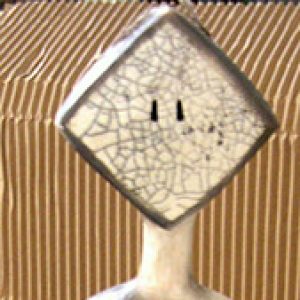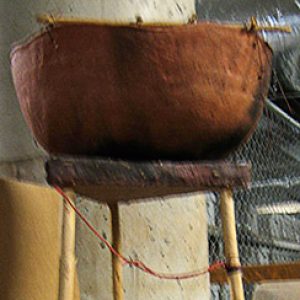calsfoundation@cals.org
Helen Ann Evans Phillips (1938–2013)
Ceramist, sculptor, and teacher Helen Ann Evans Phillips played a major role in the development of contemporary crafts in Arkansas.
Helen Evans was born on April 18, 1938, in Cincinnati, Ohio, to Harold S. Evans, a livestock dealer, and Lorna B. Evans, a homemaker. She grew up in Union City, Tennessee, and as a child spent much of her time around farm animals, drawing and making objects, as well as taking private art lessons. These early experiences influenced her sculpture later in life. She began teaching art in the Memphis City school system in 1959 before receiving her BS in painting and art education at Memphis State University in 1961.
She married Joe Phillips, a medical student, science teacher, and photographer, in 1958 and their daughter, Laura, was born the following year. She taught art in the Memphis, Tennessee, public schools from 1959 to 1964. From 1963 to 1964, she studied ceramics at the Memphis Academy of Art. Then the family moved to Okinawa, where her husband had a teaching position for the Department of Defense. While there, Phillips learned Japanese ceramic techniques from a local potter, Esabaro Arakaki. In her second year in Okinawa, Phillips taught art at the Kubasaki High School for the Overseas Department of Defense program.
Phillips and her family relocated many times, and she taught in several different locations: Germany; Hawaii, where she attended the University of Hawaii for graduate studies in Oriental ceramics; Santa Barbara, California; and Birmingham, Alabama. While in Birmingham, she attended a workshop at the Tuskegee Institute given by the British potter Michael Cardew and a Nigerian potter, Ladi Kwali. There, she learned a unique African way of creating forms by the coiling process. This process includes creating a small ledge on each coil, upon which to build additional coils in making a form. Following the Birmingham experience, Phillips attended the University of Florida at Gainesville and earned an MFA in ceramics and drawing in 1975.
The following year, the family moved to Arkansas, where Phillips joined the art faculty at the University of Central Arkansas (UCA) in Conway (Faulkner County) and put down her roots. For twenty-five years, she headed the ceramics department at UCA while residing in Little Rock (Pulaski County).
In 1980, Phillips revisited Okinawa with her daughter, an Asian studies major who was studying in Japan, and in 1992, she traveled to the Ivory Coast of west Africa to work with village women who were potters. Phillips’s sojourns in Okinawa and Africa had a profound effect on her art. She learned from both cultures and became enamored with their belief that all objects possess a natural life or vitality or are endowed with an indwelling spirit. In addition, she admired the simplicity of life that she observed.
In 1989, Phillips and her husband divorced. Her work began moving from functional, design-oriented, wheel-thrown objects to sculpture and became more introspective in tone. Her work gained greater emotional content. In recognition of her work, Phillips was awarded a fellowship by the Arkansas Arts Council in 1988. She began to study Jungian psychology, especially the interpretation of dreams. As early as 1990, Phillips’s ceramic sculpture was occupied with dream imagery as she began to explore three-dimensional sculpture. Five years later, Phillips was giving expression to her dream imaginary through objects rich in symbolic content in the form of boats, fish, birds, animals, brooding figures, open skeletal houses, window-less or closed houses mounted on stilts, and altars with golden crucibles. She blended other materials into her work such as sticks of wood stripped of bark by beavers, clipped animal hair, cords, rags, raffia, and rocks. The artist also experimented with glazes and the effect of raku firing, a technique that leaves marks of the fire on the object. A work in the collection of the Arkansas Museum of Fine Arts in Little Rock titled “It Seemed That They Were Watching” consists of two simplistic houses, mounted on the wall at eye level, that were raku fired, creating scorched surfaces on the front and a crackled white glaze on the sides. One abode has a single window, while the other has two windows indicated by narrow slits too small to allow seeing into the interior space but large enough for something to peer out. The work can be interpreted as a pair of sentinels standing in silent vigil all the while observing transactions between the secretive, mysterious houses and the outside world.
After a trip to Africa in 1992, Phillips focused her attention on African art and dream imagery that carried less personal implications. By the end of the 1990s, the artist’s work began to express her concern with environmental issues such as the loss and extinction of wildlife, her dismay at the detritus found in the environment, and modern throw-away culture with its rampant waste. Phillips’s ceramic works then began to reflect the celebration of life.
After a distinguished career as an artist and twenty-five years of teaching and being a role model for her students at UCA, Phillips retired in 2001. In 2005, Phillips and Royce Jones converted a building of the “Old Bruno School” complex in Bruno (Marion County) into a home, studio, and workshop. Although Phillips threw on the wheel, the unique coiling process was central for much of her work, especially the sculptures. Her work included sculptural forms as well as functional objects such as cups, bowls, and platters. She used a technique of combining slip and sgraffito decoration on raw clay—a technique she learned while in Okinawa.
Phillips died on November 15, 2013.
For additional information:
Cushing, Val. The Ceramic Design Book: A Gallery of Contemporary Work. Ashville, NC: Lark Books, 1988.
Du Bois, Alan. Arkansas: Year of American Craft, 1993. Exhibition catalogue. Little Rock: Arkansas Arts Center, 1993.
———. “Coming Full Circle: Ceramic Works by Helen Phillips.” Exhibition brochure. Little Rock: Arkansas Arts Center, 2002.
Leslie Schoultz
Arkansas Arts Center
Alan Du Bois
Benton, Arkansas

 Clay Sculpture
Clay Sculpture  Offering
Offering 



Thank you for this article about Helen. As her friend, I knew about her international studies but not the names. When visiting in Yellville recently, I got to see her partner at Bruno, Royce Jones. The large birds she made for me are done with coils. One won best of show at a statewide exhibit and was displayed in the window of the gift shop at Crystal Bridges.